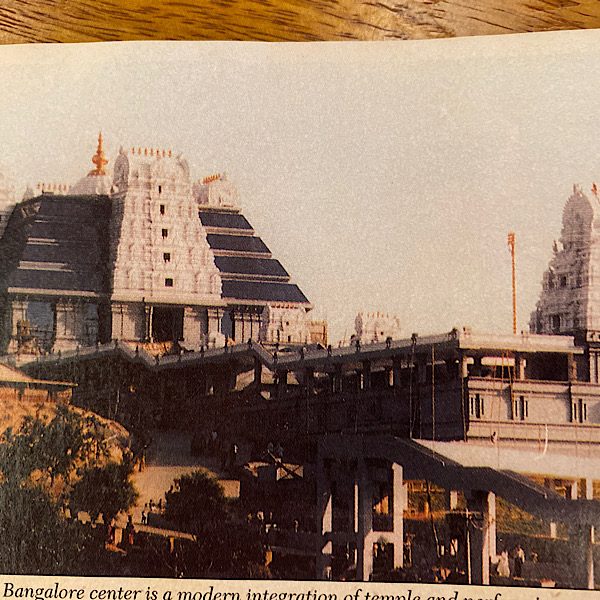This temple is a demonstration of the power of the holy name of the Lord,” declared Bangalore temple president Madhu Pandit Prabhu. “It would have never come about unless I insisted right from the very beginning that all devotees involved chant the prescribed numbers of japa, sixteen rounds of the Hare Krishna Mantra, all in the early morning hours and before breakfast.” “Sixteen rounds” is 16 times through on a set of 108 japa beads chanting on each bead, “Hare Krishna Hare Krishna, Krishna Krishna, Hare Hare, Hare Rama Hare Rama, Rama Rama Hare Hare.” That’s 1,728 rounds, 27,648 names. It’s done daily and takes about two hours.
This intense devotion culminated in the inauguration of the “Sri Caitanya Mahaprabhu Center for the Advancement of Culture,” May 21st in Bangalore presided over by the President of India, Dayal Sharma. The seven-acre complex contains five separate temples for worship, as well as an outdoor auditorium for 1,500, a 450-seat air-conditioned theater, terraced and landscaped grounds and quarters for residents and guests. The design, a blend of traditional Vedic architecture and modern technologies and materials, was developed by ISKCON engineers, including Madhu Pandit Prabhu, a graduate of the India Institute of Technology. Even before its opening, the temple had become a popular attraction for pilgrims, visitors and tourists, drawing over 2,000 a day.
Prithu das Adhikary of ISKCON told Hinduism Today, “There was not one cent of foreign money. After Madhu Pandit moved to Bangalore as the project director with his wife, he personally convinced 35 brahmacharis to join ISKCON. With their help and the help of wonderfully responsive Bangalore citizens they erected this enormous structure in just a few years. It was a perfect example of what humans can do when working together, with faith in Krishna and the power of His Holy Name.”
President Sharma spoke eloquently on ISKCON’s achievements. “This magnificent complex: a blend of tradition and modernity, is a symbol of the dedication of ISKCON to the cause of bhakti [love of God] and service. ISKCON has spread the message of bhakti throughout the world. Over the years, the society has provided relief and succor and has brought peace and harmony into the lives of millions of people. It has grown and flourished in many countries and continents. In India, the activities of ISKCON are rekindling the latent knowledge and awareness among our own people of our great spiritual and cultural heritage. I wish the center many years of fruitful service to society.”
A recent visitor to the newly opened temple described it to Hinduism Today as “looking really grand.” “The temple is up on a hill and the walkway was crowded with people, top to bottom, the day I went.” he continued. “Young brahmacharis managed an orderly crowd with walkie-talkies. First there is the giant stall and elaborate system for pilgrims’ footware. The queue moves on to the main mandapam. It was huge but unlike the old ornate Agamic temples in Tamil Nadu we were used to. It had a massive open hall, very clean, with a high ceiling, finished with polished granite everywhere. In the middle of the hall a bhajan group was soulfully singing. Tourists, curiosity seekers and devout worshipers passed in front of the three shrines. Three priests did puja, waving fans, arati, etc., in strikingly perfect synchronization. After darshan the queue goes below to a ground floor filled with stalls and information booths. Prasad, sanctified food, is distributed at the exit. When we were leaving, it had run out. We were passionately asked to wait, as no one was permitted to leave until newly offered prasad could be given.”
The temple sits atop a rocky hill near a burgeoning computer industry which has earned the area a reputation as India’s “Silicon Valley.” The land was alloted to ISKCON by the former Karnataka Chief Minister, Ramakrishna Hedge. The local Rotary Club named Madhu Pandit Man of the Year for his achievements with the center.
Gift: India’s President receives Gopal deity from ISKCON’s Jayapataka Swami


